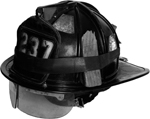

This chapter includes a brief discussion of basic hand tools, power tools, and measuring tools, but the main emphasis is on tools specific to firefighting, used not only on the fireground but also in the firehouse during maintenance operations. This chapter and Chapter 10, “Principles of Mechanics,” provide the reader with a comprehensive review of tools and how and why they are used.
The following is a basic review of the types of tools that candidates preparing for the firefighter exam should be familiar with.
A nail hammer is among the most widely used hand tools. It is used for striking and removing nails. Hammers are made in two general patterns: straight claw (ripping) and curved claw. Handles are made of wood, steel, or fiberglass. A hammer blow should always be struck squarely with the striking face of the hammer parallel to the object being struck. When striking another tool (chisel, wedge, hand punch, etc.), the hammer’s striking face should have a diameter larger than the struck face of the other tool.
In addition to the basic straight and curved claw hammers, there are hammers designed for specialized purposes, such as light-duty tack hammers designed for driving small nails; round ball-shaped ball-peen hammers for riveting and shaping unhardened metal; soft-face hammers, or mallets, made from wood or rubber and designed for delivering blows to objects that would mar if struck with a metal hammer, and drywall hammers designed to dimple drywall prior to nailing.
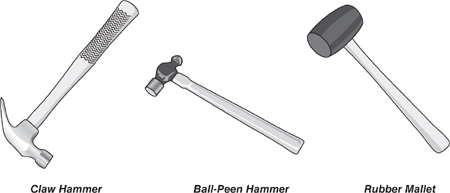
Nails are made from wire. They range in length from 2 d (1 inch) to 60 d (6 inches). The abbreviation “d” is used for the term penny and is derived from the first letter of the Roman coin denarius. The common 16 d penny nail is 3½ inches long and is used to fasten structural building elements together. Other types of nails include concrete, drywall, finishing, ring, roofing, shingle, and spiral nails.
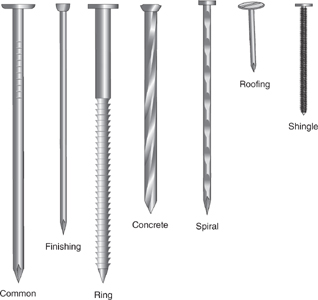
Various types of chisels are used for cutting, shaping, and trimming different materials. A cold chisel made from steel is used for cutting and shaping metals such as cast iron, bronze, and copper. A wood chisel is designed for rough work on wooden materials. A masonry chisel is used with a hand drilling hammer to score or trim brick or block.

Pliers are hand tools used to grip, turn, pull, or crimp a large variety of objects. Pliers direct the power of the handgrip into a precision grip. The long handles in relation to the nose of the pliers act as levers, enhancing the force in the hand’s grip to the object being acted upon.
The variety of pliers today exceeds most, if not all, other types of hand tools. Linesman pliers with a side cutting feature bend lightweight metal and sever wire. Wire stripping (electrician) pliers sever and remove insulation on electrical wire without damaging the wire. Long-nose or needle-nose pliers are used to grip and shape lightweight metal; the slim head design facilitates crimping wires in confined, narrow spaces. Locking pliers, also called LockJaw or Vise-Grip pliers are basically a handheld vise that allow for the purchase on an object to be locked in and tightened prior to applying force. They are used to firmly grip lightweight metal or remove round door-lock cylinders.

Wrenches are used for tightening and loosening nuts, bolts, pipes, and many other objects that are hard to turn. The tool works as a lever. The mouth of the wrench is used to grip the object to be turned. The wrench is pulled at a right angle to the axis of the lever action and the turned object. Wrenches can be nonadjustable or adjustable to fit better around objects of various sizes that need to be turned.
An open-end wrench is a one-piece wrench with a smooth, U-shaped opening(s). It is designed to grip two opposite faces of a bolt or nut from the side. This is advantageous in areas that are difficult to access or are obstructed.
A box-end wrench is a one-piece wrench with recessed, grooved, enclosed opening(s). It is often designed double-ended with different-sized box ends. The enclosed opening grips all the faces of the bolt or nut providing more torque than the open-end wrench without slipping or stripping the bolt or nut. A combination wrench is a double-ended tool with one end open and the other end enclosed. Both ends generally fit the same size bolt or nut.
An offset wrench is designed to provide access to obstructed bolts and nuts in recessed areas. It allows for hand clearance when turning an object flush with a work surface. An adjustable (crescent) wrench is an open-end wrench with smooth, adjustable jaws used to turn bolts or nuts. A pipe or Stillson wrench is an adjustable wrench having serrated jaws for gripping soft iron pipe and pipe fittings. A hex key (Allen) wrench is an L-shaped, six-sided wrench used to turn machined setscrews or bolt heads designed with a hexagonal recess. And, finally, the well-known monkey wrench (named for its inventor, Charles Moncky—I kid you not!) is an old-type adjustable wrench with smooth jaws that is used for turning bolts or nuts.
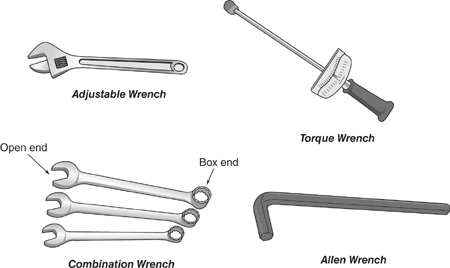
A ratchet box, designed for turning bolts or nuts, has a mechanism that eliminates the need to readjust the wrench during the return stroke. A socket with ratchet handle is a hollow cylinder (socket) that fits over a bolt or nut head, used in conjunction with a drive tool (ratchet handle). Sockets are generally sold in sets of various sizes.

The simple handheld screwdriver is designed to tighten or loosen and remove screws. It consists of a tip or head at the end of an axial shaft that is encased inside a cylindrical handle. The handle allows the shaft to be rotated, thereby applying torque at the tip. Screwdrivers are made in a wide variety of sizes to match different screw sizes. Screwdriver heads come in many types, the most common of which are mentioned below.
A slot-head screwdriver is a flat-bladed screwdriver that fits a single slot screw. A Phillips head screwdriver is a cross-headed screwdriver with rounded corners. It is designed to slip off the screw when under high torque to prevent overtightening. A hex head (Allen) screwdriver has a six-sided head and is used as an alternative tool to the hex key wrench. An offset screwdriver is used to access hard-to-reach and obstructed screws where a straight shaft screwdriver is inappropriate. A ratchet screwdriver is designed for high-speed turning using a ratchet handle.
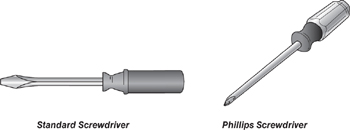
The key component of the saw is a blade with a cutting edge. Other components include the heel, the end closest to the handle; the toe, the end farthest from the handle; the front, or bottom edge; and back, or top edge.
There are many different types of saws, designed for specific uses. The most common saws are mentioned below.
A crosscut saw is designed for making cuts in lumber perpendicular (at a right angle) to the grain. The cutting edge of the blade is beveled, allowing the blade to act like a knife edge and slice through the wood. A ripsaw is designed for cutting lumber parallel to the grain. The saw teeth are substantially steeper than those in a crosscut saw and have flat front edges that act as chisels. Both of these saws (like most Western saws) cut as they are pushed through the wood; unlike Japanese-type saws that cut on the pull stroke.
A backsaw is a thin-bladed saw having a reinforced steel or brass back that is thicker than the blade itself and limits the depth of the cut. The teeth of the blade are closely spaced. A miter saw is a back or metal-framed saw with replaceable blades. It is designed to make crosscuts and is used with a miter box to make precise angle cuts.
A hacksaw is a fine-toothed saw with the blade under tension inside a frame. It is designed to cut metal. Finally, a coping (jigsaw) is designed to cut intricate shapes in wood. It has a thin blade tensioned inside a metal frame.
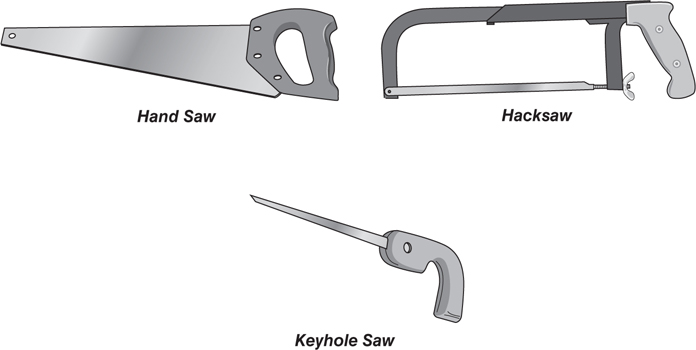
Bars are made of metal and come in a variety of shapes and sizes. They are generally used as first- and second-class levers for general demolition purposes (tearing out walls, removing moldings, prying apart objects, and removing nails), but are also used for chiseling, scraping, opening wooden boxes or crates, and lifting.
A crowbar (wrecking bar) is a long-handled, relatively heavy metal tool with one curved end (claw) for prying and removing nails and one flattened end.
A pry bar is a long-handled metal tool, generally smaller and lighter than the crowbar. It has one flattened end and one tapered, pointed end and is used for prying, lifting, and removing nails. A combination pry bar and chisel tool, an offset rip bar, is similar in appearance to the crowbar. It has a small claw end and wide chisel end in an offset pattern for difficult-to-reach objects. A utility pry bar, a small, lightweight metal tool having beveled cutting edges at both ends, is designed for pulling nails, prying light objects, and scraping. A cat’s paw is a small-handled pry bar with one flattened end and one rounded, curved end for prying and removing nails.
A nail puller is a metal bar designed to easily slide under the head or into the shank of an embedded nail for easy removal. The other end is a striking head for a hammer.
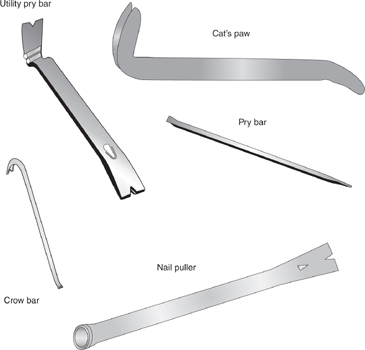
Other common hand tools include hand punches designed to mark metal and other surfaces softer than the punch itself and to align holes and drive or remove pins and rivets; drift pins used for aligning holes in metal; and star drills used, along with a hand drilling hammer, to drill holes in masonry.
Power tools are basically hand tools that use electrical, pneumatic, or fuel power. Many common hand tools discussed above are now also available as power tools.
Different types of saws are available as power tools. A circular saw with a rotary blade is used for cutting wood; a reciprocating saw, with a thin, straight blade, is used for cutting metal, pipe, and wood; a lightweight jig, or saber saw, is used to cut custom designs in soft wood and light metal; and a chain saw is used for logging, tree trimming, and harvesting firewood.
Drills use compressed air or are electrically powered to provide enhanced torque for general-purpose drilling, wire brushing, screwing, and other uses on metal, wood, and concrete materials. They come with different-sized steel drill bits and other attachments.
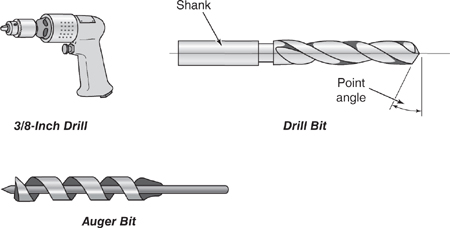
A soldering iron is an electrically powered device consisting of a handle upon which is mounted a heating element (bit) that applies heat to melt solder (lead and tin alloy) for joining metal components together. It is used in electrical work to connect wires and on circuit boards.
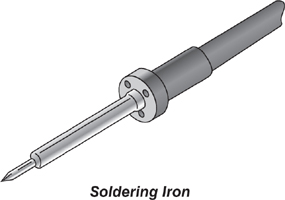
A sander uses compressed air or electric power to sand, polish, and otherwise provide prepainting preparation on both wood and metal.
A nail gun is a compressed air tool powered by electricity or a battery that provides fast, consistent nail penetration into lumber.
Other power tools include the impact socket wrench used in automotive work; a bench grinder used to polish and sharpen tools; an air chisel used to cut lightweight metal, masonry, and wood; and a spur point used for drilling holes for dowels in woodworking.
Common measuring devices are the tape measure, level, and chalk line tool, which is a chalk-covered cord inside a metal casing that when stretched taut between two points and snapped leaves a straight chalk line on a surface. Calipers, devices used to measure the thickness and internal and external size of an object, are also used; some, known as vernier caliper, provide accuracy to one ten-thousandth of an inch.
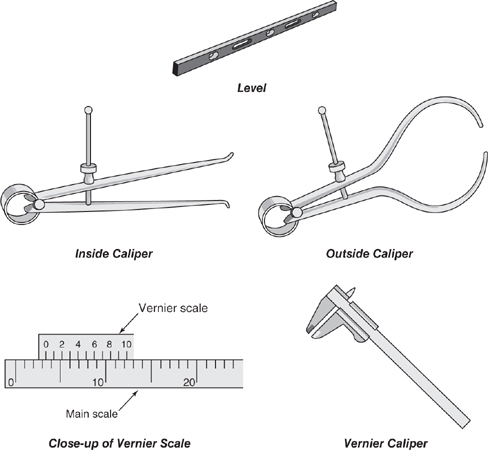
This section focuses on tools and equipment used by firefighters on the fireground. The tools and equipment may be grouped into two categories: engine company and ladder company tools and equipment.
The engine apparatus contains an abundance of hoses, nozzles, tips, fittings, and appliances needed for firefighting operations.
Hoses are classified by inside diameter and construction material. A length of hose is approximately 50 feet, with a male coupling (connector) on one end and a female coupling (connector) on the other end. Hose couplings can be standard type (male/female threaded) or hermaphrodite type (identical, nonthreaded).
A male coupling has a nonswiveling (solid) connection whose threads are located externally. A female coupling has a swiveling connection whose threads are located internally. A hermaphrodite coupling is a quick-connect coupling having no threads; identical connections are found at both ends of this type of hose. Generally, connections are made on hermaphrodite couplings using a half-turn rotational action.
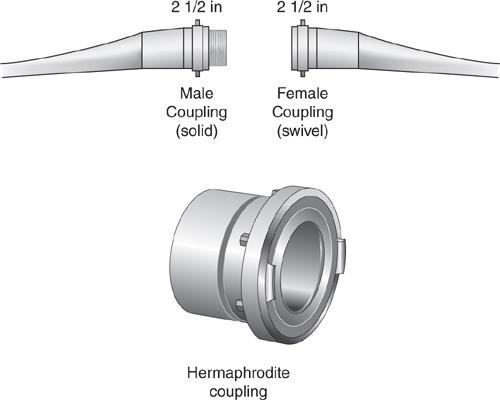
A booster tank hose is a small diameter (½ to 1 inch), rubber-covered hose preconnected to the pump and water (booster) tank of the engine apparatus. It can be used by one firefighter as a handline stretched off an apparatus reel to extinguish small outdoor fires.
A handline (attack) hose is a handheld hose line with a fabric, polymer, or rubber covering. It provides approximately 150 to 250 gallons per minute (GPM) and generally requires more than two firefighters to stretch and operate as an interior attack hose line. It is stretched off the back or side hose bed of the apparatus to extinguish fires inside buildings during interior structural firefighting operations.
A supply (large diameter) hose is a hose line generally 3 to 6 inches in diameter having a covering of fabric, polymer, or rubber. It is used to provide water at greater than 250 GPM to fire apparatus, large caliber stream appliances, and building fire extinguishing systems.
Nozzles and tips are designed to provide a fire stream of water or foam extinguishing agent. Nozzles are attached to handlines and have shutoff mechanisms designed to close, open, and regulate hose streams. Tips are also attached to handlines but do not have shutoffs and are placed on nozzles and fire extinguishing appliances to provide a fire stream in various patterns (straight, narrow, wide, fog). A smooth solid bore, straight stream tip is, for example, designed to produce a compact, penetrating stream with little breakup; a fog nozzle provides a wide or narrow patterned water stream composed of fine droplets; and a foam nozzle mixes water, foam concentrate, and air to produce a foam extinguishing agent stream.
Fittings are devices used in conjunction with hose line couplings to solve hose connection problems. An increaser has larger-sized male coupling threads than female threads, whereas a reducer has larger-sized female coupling threads than male threads. A double male connection is a fitting with male coupling threads on both ends, used for connecting two female couplings together; a double female connection, a fitting with female coupling threads on both ends, is used for connecting two male couplings together.

A National Standard Adapter is a fitting permitting National Standard appliances, fittings, and hoses to be used with local fire department equipment. It has local fire department threads at the female end and the National Standard thread at the male end.
Appliances are connected to hose lines or hydrants and are used to control, augment, divide, and discharge water streams or fire extinguishing agent. A ball valve is a flow control appliance used to open and close the flow of water in a supply hose line. They are in the open position (water flowing) when the handle is in line with the hose and closed when the handle is at a right angle to the hose. A gate valve is used to open and close the flow of water from a hydrant. It has a baffle that moves up and down through the turning of a handle.
A wye is an appliance that divides a supply hose line entering through its female inlet into two equal hose lines of smaller diameter out its male outlets. It may or may not have control handles (gates) for its male outlets.
A water thief is an appliance that divides a supply hose into three hose lines, one of the three being of larger diameter than the other two.
A Siamese is an appliance used to augment a supply hose line or building fire extinguishing equipment. It consists of two or more female inlets and one male outlet.
A hose jacket is a metal or leather encasing appliance used to reduce leakage from cut, damaged, or improperly coupled hose lines.
Master (deluge) nozzles are appliances (generally straight stream) with smooth solid bore tip(s) used to direct a large (300+) GPM water stream. They are connected to a Siamese in order to ensure an adequate water supply.
Monitor nozzles are used from the ground position. Deck pipes are mounted atop the engine company’s apparatus. Ladder pipes are attached to the lead ladder section of a ladder company’s aerial apparatus.
A distributor is an appliance with swiveling/rotating outlet heads attached to a supply hose line. It is used to produce a circular, spray pattern of water in hard-to-access areas (basements, cellars, piers). It is equipped with handles so it can be supported when suspended through the opening it is operating into.
A cellar pipe is a cylindrical appliance with a control handle consisting of one or two straight tips. It is attached to a supply hose line to produce a horizontal water stream through flooring into sublevel areas.
Other tools commonly carried and used by an engine company include the following:
A hose bridge is a ramp appliance permitting vehicles to roll over hoses and couplings without damaging them.
A hydrant wrench is a tool (box wrench or adjustable wrench) used to open the valve of a fire hydrant.
A hose spanner is a rigid metal tool used to loosen and tighten hose line couplings.
A hose roller hoist is a curved metal device with two or more rollers designed to fit over a windowsill or the edge of a roof. It is used in conjunction with rope to safely raise or lower hose and equipment.
A hose strap is a short length of rope with an eye-loop at one end and a metal hook at the other end. It is wrapped around a hose and tied off to a banister or railing to support the weight of hose couplings when hose lines are stretched vertically up stairwells and fire escapes and charged with water.
The ladder company apparatus also has a wide array of tools to aid the firefighter in completing firefighting tasks. Some of these tools include ladders, ropes, forcible entry tools, ventilation fans, and tarps.
Hand-operated (ground) portable ladders are tools used by firefighters to reach areas that cannot be accessed by normal means. They come in a variety of lengths, from less than 10 feet to more than 50 feet.
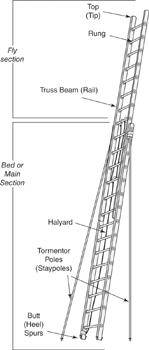
Ladders commonly used by firefighters are listed below.
Single (straight) ladder—A ladder that is nonadjustable in length and consists of only one section, a single (straight) ladder generally ranges in length from 12 to 24 feet and can be placed into operation by one firefighter acting alone. A single straight ladder is used for quick access to the roofs and windows of two-story structures.
Extension ladder—A ladder that is adjustable in length and generally consists of one or more movable sections beyond the base, an extension ladder uses a rope (halyard) and pulley system for extension and retraction. It ranges in length from 24 to 50 feet and is usually placed in operation by two or more firefighters.
Combination ladder—A ladder designed to be used three ways—single, extension, and A-frame; a combination ladder ranges in length from 8 to 14 feet.
Roof ladder—A single, straight ladder with folding hooks attached to the beams at the top end that grab the roof ridgepole. A roof ladder is designed to allow firefighters to work atop and ventilate peaked roofs.
Folding (suitcase) ladder—A single, straight ladder with hinged rungs allowing it to be folded for carrying through narrow spaces like hallways and to access tight spaces such as closets. A folding, or suitcase, ladder comes equipped with nonslip safety shoes at its butt end.
Pole ladder—A pole ladder is a maximum-length extension ladder having stay poles attached to the outside of each beam for enhanced stability.
Pompier (scaling) ladder—A single beam ladder with rungs extending out on both sides, a pompier ladder is designed to be inserted into windows to allow firefighters to climb building facades. It is not designed to rest on the ground. It has a large hook at the top that is inserted into a window and ranges in length from 6 feet to 20 feet. (The word pompier means firefighter in French.)
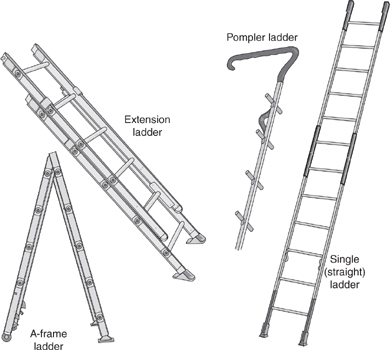
Ropes are used in a variety of ways by firefighters. They can be employed to hoist, secure, and lower tools, hoses, and appliances and for search-and-rescue purposes.
The part of a rope that is used in tying knots is known as the working end. The long part not used when tying knots is the standing end.
Ropes are made of several types of materials, each with its characteristic properties.
Nylon rope—The strongest rope in common use, a nylon rope is excellent in absorbing shock loads when used for rescue and lifting loads and has superior abrasion, oil, and chemical resistance properties.
Polyester rope—A strong rope that stretches very little, a polyester rope doesn’t have the shock-absorbing capability of nylon rope.
Polypropylene rope—A lightweight rope, a polypropylene rope is the only rope used in the fire service that floats, and it is therefore used in marine firefighting operations. It is not as strong as nylon or polyester.
Natural fiber (Manila)—A type of rope that holds knots firmly and stretches very little, a natural fiber rope is subject to deterioration by chemicals and mildew.
Ropes are used for numerous purposes in firefighting operations.
Lifesaving rope—Approximately 150 feet long, a lifesaving rope is used to lower firefighters and victims from dangerous positions during fire operations.
Personal rope—Approximately 50 feet long, a personal rope is used by firefighters to lower themselves from dangerous positions.
Search rope—Approximately 200 feet long, a search rope is used by firefighters as a retrieval lifeline and to perform searches safely in large, complex areas. It provides a fixed anchor point to keep firefighters from becoming disoriented during searches.
Utility rope—Approximately 40 feet long, the utility rope is a multipurpose rope used for securing tools and equipment. It is not used for lifesaving purposes.
Making knots in rope entails tying the parts of one or more ropes together. Knots are used by firefighters to perform many tasks, such as temporarily securing an object with a hitch or single/simple knot. Knots are also used to make a rope longer by tying two ropes together (bend knot). A rope can also be bent to form two parallel sides (bight) or made into a loop by crossing the sides of a bight.
There are many different types of knots, including the following:
Overhand (thumb) knot—The simplest of all knots, an overhand knot is used as a safety hitch or binder to ensure a knot will not loosen.
Half-hitch—A half-hitch knot is used to hoist and lower tools and equipment.
Clove hitch—Formed by making two half-hitches and secured with an overhand knot (binder), a clove hitch is also used for hoisting and lowering tools and equipment.
Rolling hitch—A rolling hitch is a series of half-hitches used to secure hose lines that have been hoisted along the exterior of the building. They are generally secured with a binder.
Becket bend—Also known as a sheet bend, a becket bend knot is particularly suited for tying two ropes of unequal diameter together.
Square knot—A square knot is used to tie two ropes of equal diameter together.
Bowline—A bowline knot will not slip or tighten under tension and is used for hoisting and lowering portable ladders.
Bowline on a bight (rescue knot)—Used to lower and lift firefighters and victims from roofs, windows, and confined spaces during rescue operations. A bowline is used to support the body, while the bight prevents the rope from tightening and slipping. It is used in conjunction with a slippery hitch to secure the working end of the rope during lowering and lifting rescue operations.
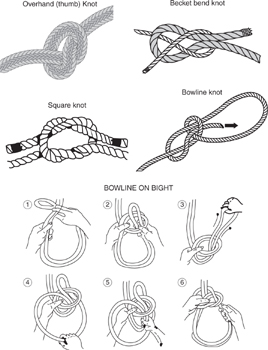
Forcible entry tools are designed to break and pry locks and locking devices to gain entry into buildings and fenced-in areas during fire and emergency operations. These tools are also used for forcibly opening and entering doors, windows, and roof openings, as well as for striking, pulling, prying, and removing building material components (roofing, plaster, drywall, wood lath, brick, masonry, tile) in search of hidden fire.
Halligan tool—Originally designed by Deputy Chief Hugh Halligan of the Fire Department of New York in the 1940s, the Halligan tool is a metal bar tool that has on one end a spike (for ripping and prying) and an adz (for chopping, prying, and cutting) at right angles to each other and at the opposite end a fork (for prying and cutting). Traditionally it is nested with the axe to form a firefighter’s set of forcible entry “irons.” It is used for forcing open doors, windows, and locks.
Flat head axe—A flat head axe consists of a 6 to 8 pound steel head attached to a long wooden or fiberglass handle. The head has a flat poll side designed for striking as well as receiving hammer blows and an axe blade for cutting. It is “married” to the Halligan tool for forcible entry work or used separately for cutting floorboards, roof boards, and windowsills.
Pick head (fire) axe—A pick head (fire) axe has a 6- to 8-pound pound head attached to a long wooden handle. The head has a square, pointed pick on one end and an axe blade on the opposite end. The pick end is designed for enhanced penetration through and prying of floor and roof boards.
Kelly tool—One of the original firefighting forcible entry tools, the Kelly tool, which was designed by FDNY Captain John Kelly of Ladder Co. 163, is a metal bar tool with a fork end and an adz end that protrudes into a hammerhead for striking and receiving hammer blows. It is designed for lock breaking.
Claw tool—Another original firefighting forcible entry tool, the claw tool is a metal bar tool having a hook (claw) at one end and a fork at the other.
T-N-T (Denver) tool—A multipurpose, forcible entry hand tool. The T-N-T, or Denver, tool is designed to perform the work of an axe, pry bar, ram, pike pole, and sledgehammer. It is used on automobiles and inside buildings.
Maul/sledgehammer—A heavy, long-handled hammer having a head with two flat striking surfaces, the sledgehammer is used for forcible entry and breaking up walls and flooring consisting of drywall, concrete, tile, brick, and masonry.
Battering ram—A battering ram is a heavy metal bar designed to be used by two or four firefighters for pushing in heavy doors and breaching walls.
K-tool—A square (3 inches by 3 inches) steel block with a sharp-edged K-shaped notch on one side. The K-tool is designed to be slipped over cylinder locks to remove them. The other side of the tool has a U-shaped flange for prying when used in conjunction with metal bar tools.
Automatic center punch—A metal, hand-sized spring-loaded pointed tool, an automatic center punch is used by firefighters to break tempered glass in vehicles during extrication emergencies.
Shove knife—A shove knife is a rigid, flat metal blade used by firefighters to retract door spring latches during forcible entry.
Hydraulic spreader (Jaws of Life)—A mechanical levering tool powered by a hydraulic pump engine, the Jaws of Life is used for forcible entry and spreading of car components (doors, hood) to permit extrication of trapped victims.
Hydra-Ram—A lightweight hydraulically operated forcible entry tool consisting of a control handle and working end piston, a Hydra-Ram is used primarily by firefighters to force inward- and outward-opening doors.
Pneumatic air bags—Bags constructed of neoprene rubber reinforced with steel that are inflated using compressed air cylinders, pneumatic air bags are designed to move and lift heavy loads.
Power saw—A power saw is a portable, gas-fueled tool. A power saw uses circular blades to cut wood, lightweight metal, and masonry.
Oxyacetylene cutting torch—Using a mixture of oxygen and acetylene, this burning tool is used by firefighters to cut locks, heavy iron bars, and metal plating.
Poles (hooks)—Poles are long-handled tools primarily designed for opening up (pulling) ceilings and walls made of drywall (Sheetrock) and wood lath in the search for hidden fire. They are also utilized by firefighters to vent windows and roof openings (skylights, scuttle covers) as well as to pull up roof coverings and roof boards. Poles come in a variety of lengths from less than 5 feet to more than 15 feet.
Pike pole (hook)—A long (6 to 15 feet), wooden-handled striking and pulling tool used on windows, ceilings, and partition walls. The steel head of the tool has a short hook for pulling and a pointed tip for striking and penetrating through plaster, drywall, and wood lath. There are several types of pike poles, or hooks, including a closet hook, which is a short (under 5 feet), wooden D-handled pike pole for use in small, tight spaces; a multihook with a pointed, penetrating metal head and two flared adz end hooks for a greater pulling surface and easier removal of large areas of material in comparison to the pike pole; and a Sheetrock hook with a pointed metal head consisting of a 4-inch, toothed curved hook for a larger contact point and pulling surface. It is specifically designed to facilitate the pulling and removing of Sheetrock, lath, and plaster.
Positive pressure ventilation (ppv) fans—Electric or fuel-driven fans primarily designed to provide forced, uncontaminated air into a room or building to displace the by-products of fire (smoke and toxic gases).
Smoke ejectors—Fans primarily designed to eject smoke and toxic gases from an area. They have some use in drawing fresh air into an area but do not move as much air as positive pressure fans.
Salvage operations require specialized equipment. The following are some of the more common types of tools or equipment used.
Salvage covers are generally used indoors to protect furniture, equipment, and valuables from water damage, but they may also be used as a chute to funnel water out windows and down staircases. The tarpaulins are made of canvas, waterproof-treated drop-cloth material, or plastic, with reinforced edges and grommets for hanging.
Plastic sheeting is used to cover openings on roofs and windows to protect the interior of the structure from adverse weather conditions.
Dewatering pumps are electrical, engine-driven, and hydraulic-powered pumps used in conjunction with a hose line to lift and remove water from below-grade areas.
Water vacuums are designed to suction off water from floors and carpeting. These devices consist of a vacuum nozzle and catch tank worn on the back of the firefighter.
To protect their health and lives, firefighters use a variety of safety equipment while performing their duties. Some of this equipment is discussed briefly below.
Self-contained breathing apparatus (SCBA)—Firefighters wear self-contained breathing apparatus during interior structural firefighting operations to protect against breathing toxic fumes and smoke. An SCBA is also used inside confined spaces where insufficient oxygen or poisonous vapors are present. The SCBA supplies compressed, breathable air to the wearer and includes an air cylinder, high and low pressure hoses, a regulator, and a facepiece. It may or may not have an integral alarm device that operates automatically should the firefighter become disabled.
Personal alert safety system (PASS) device—A personal alert safety system is an alarm device that emits a signal when a firefighter is disabled, lost, or otherwise in distress. It can be activated both manually and automatically should the firefighter stop moving for an extended period of time.
Respirator—A respirator is a full-face or half-face respiratory protection device that protects the user by filtering out dust particles, organic vapors, and acid gases. The device has replaceable cartridges. The term is also used for disposable dust and paint masks, which lack filters and do not provide protection from organic vapors and acid gas. Air-purifying respirators (APRs) remove contaminants by moving ambient air through a filter. APRs can have a full or partial facepiece.
Bunker (turnout) gear—The structural firefighting ensemble (coat and pants) that provides flame, thermal, and mechanical (cuts, abrasions) protection is known as bunker gear. The term may also refer to the entire firefighting ensemble, including helmet, hood, and boots. The gear is made from fire-resistant fiber, synthetics, and polymer materials, such as Nomex, Kevlar, and polybenzimidazole (PBI), and generally has high-visibility striping material.
Reflective vest—A reflective vest is a high-visibility garment worn over firefighting clothing. It is used by firefighters when working with and around cranes and heavy construction equipment and trucks during technical rescue and building collapse operations.
Fire helmet—Constructed of fiberglass, plastic, or leather, the helmet firefighters wear provides thermal and impact head protection during firefighting operations. A long curved rear brim keeps cinders and hot runoff water off the firefighter’s neck. The helmet also provides thermal ear protection (ear flaps) and eye protection (eye shields), and it has a chinstrap to secure the helmet to the head.

Hood—Made from fire-resistant material similar to that used for manufacturing bunker gear, the hood is worn over the head to protect the areas of the head and face not covered by the helmet and facepiece of the SCBA.
Fire boots—Structural firefighting footwear, or fire boots, made from rubber and/or leather, provide thermal (Nomex/Kevlar), puncture, and impact (steel sole/shank/toe) protection of the foot, ankle, and lower leg. Some boots are designed in lengths to be pulled up over the knees for enhanced thermal protection of the lower extremities.
Additional protective gear—Includes earmuffs/earplugs, safety glasses/goggles, kneepads, safety shoes, and gloves, all made of material designed to protect the firefighter. Firefighters working in confined spaces and in technical rescue work wear a hard hat.
Firefighters also use flashlights, pocketknives, and portable fire extinguishers in their duties. A thermal imaging camera, a handheld heat-detecting tool that uses infrared rays to find hidden fire and disabled victims inside a building under smoky firefighting conditions, is another invaluable tool. A multigas detector, a metering device that detects and measures oxygen level, as well as toxic (hydrogen cyanide) and flammable (carbon monoxide) gases, is also a valuable tool.
Firefighters at times need to employ tools that are generally used in specific trades. For example, they may use circuit meters, multimeters, and voltage continuity testers to measure a household’s electrical condition (current flow, voltage, leakage, and resistance). In maintaining the fire station, they may use painting, woodworking, masonry, glazer, and plumbing tools. Basic automotive tools are used when maintaining the fire apparatus.
Wildland firefighting tools and equipment include buckets, hoes, rakes, shovels, swatters, and brooms. It is beyond the scope of this book to discuss all of these tools in detail, but a short list of some of the most common pieces of equipment used in wildland firefighting follows.
Bambi bucket—A collapsible bucket slung below a helicopter that is dipped into a source of water (lake, river, or reservoir) and emptied onto the fire.
Drip torch—A handheld container with a fuel fount, burner arm, and igniter, used to ignite a prescribed burn by dripping flaming liquid fuel (diesel fuel and gasoline) on foliage and brush.
Pulaski tool—A wooden-handled, steel-headed tool with an axe blade at one end and an adz blade on the other end, used for chopping and trenching. Invented by USFS ranger Ed Pulaski in 1911.
McLeod tool—A long, wooden-handled tool that is a combination rake and hoe, with one serrated edge for raking and one sharpened edge for cutting and hoeing. Designed by Sierra National Forest ranger Malcolm McLeod in 1905.
Knapsack (Indian) pump—A backpack-mounted water tank or bladder bag (5 gallons) equipped with a high-pressure, double-action squirt pump used like a portable fire extinguisher for small brush fires.
Round point shovel—A long, wooden-handled tool with a narrow, pointed blade designed for digging out burning roots and logs and burying smoldering fires with dirt.
Fire rake—A long, wooden-handled rake with steel teeth, used for raking fire lines and cutting under brush and foliage.
Fire swatter (flapper)—A flexible, square-shaped rubber flap connected to a long handle, designed to beat out or smother a small ground fire or burning embers.
Fire broom—A broom used in fire line construction and in patrolling fire breaks.
Fire shelter—A last-resort personal life safety device made of several layers of aluminum foil, silica cloth, and fiberglass that reflect most of a fire’s radiant heat and can be deployed quickly.
Circle the letter of your choice.
1. The type of hammer used primarily for striking and removing nails is called a
(A) curved claw hammer
(B) ball-peen hammer
(C) tack hammer
(D) hand drilling hammer
2. Which of the following is a tool that is made from wire and is commonly used to fasten structural building elements together?
(A) A drift pin
(B) A wood splitting wedge
(C) A star drill
(D) A nail
3. A chisel used for cutting, shaping, and removing metals such as cast and wrought iron, steel, and bronze is called a
(A) wood chisel
(B) cold chisel
(C) nail set
(D) masonry chisel
4. Pliers with a high-leverage gripping action that are designed to bend lightweight metal and have a side cutting feature to sever wires are called
(A) wire stripping (electrician) pliers
(B) long-nose or needle-nose pliers
(C) linesman pliers
(D) LockJaw (Vise-Grip) pliers
5. Pliers with a long, slim head designed to facilitate crimping wires in confined, narrow spaces are called
(A) diagonal cutting pliers
(B) groove-joint (channel lock) pliers
(C) end cutting pliers
(D) long-nose or needle-nose pliers
6. Pliers primarily designed to sever and remove insulation on electrical wire without damaging the wire are called
(A) wire stripping (electrician) pliers
(B) long-nose or needle-nose pliers
(C) linesman pliers
(D) diagonal cutting pliers
7. Pliers that can be locked in and tightened prior to applying force are called
(A) wire stripping (electrician) pliers
(B) groove-joint (channel lock) pliers
(C) LockJaw or Vise-Grip pliers
(D) slip-joint pliers
8. A one-piece wrench with smooth U-shaped opening(s) that is designed to grip two opposite faces of a bolt or nut is called a (an)
(A) box end wrench
(B) monkey wrench
(C) open-end wrench
(D) combination wrench
9. A wrench that is constructed with a mechanism that eliminates the need to readjust its position during the return stroke is called a (an)
(A) adjustable (crescent) wrench
(B) offset wrench
(C) socket with screwdriver handle (nut driver)
(D) ratchet box wrench
10. An L-shaped, six-sided wrench used to turn machined setscrews or bolt heads that are designed with a hexagonal recess is a
(A) hex key (Allen) wrench
(B) star key (Torx) wrench
(C) socket with screwdriver handle (nut driver)
(D) torque wrench
11. Flat-bladed screwdrivers are called
(A) Phillips head screwdrivers
(B) Pozidriv head screwdrivers
(C) slot-head screwdrivers
(D) Frearson head screwdrivers
12. Cross-headed screwdrivers with rounded corners, designed to slip off a screw when under high torque to prevent overtightening, are called
(A) slot-head screwdrivers
(B) Pozidriv head screwdrivers
(C) Frearson head screwdrivers
(D) Phillips head screwdrivers
13. A screwdriver used to access hard-to-reach and obstructed screws where a straight shaft screwdriver is inappropriate is termed
(A) stubby
(B) offset
(C) irregular
(D) cylindrical
14. A type of saw designed with a blade for cutting lumber perpendicular to the grain as it is being pushed through the wood is called a
(A) ripsaw
(B) miter saw
(C) crosscut saw
(D) hacksaw
15. A type of saw made to cut lumber parallel to the grain with a flat front edge that acts as a chisel is called a
(A) backsaw
(B) crosscut saw
(C) coping (jigsaw)
(D) ripsaw
16. A thin-bladed saw with closely spaced teeth having a reinforced steel back that is thicker than the blade itself is called a
(A) backsaw
(B) bucksaw
(C) bow saw
(D) chain saw
17. A type of saw that is designed primarily to make crosscuts and precise angle cuts on lumber for picture framing and for ceiling/wall molding joint connections is called a
(A) bucksaw
(B) miter saw
(C) coping (jigsaw)
(D) ripsaw
18. A long-handled, heavy metal demolition tool with one curved end (claw) for prying and removing nails and one flattened end is called a
(A) pry bar
(B) pinch (Jimmy) bar
(C) crowbar (wrecking bar)
(D) nail puller
19. A long-handled tool with one flattened end and one tapered, pointed end that is designed for prying, lifting, and removing nails is called a
(A) nail puller
(B) cat’s paw
(C) crowbar (wrecking bar)
(D) pry bar
20. A small-handled, lightweight pry bar having one rounded, curved end designed for prying and removing nails and one flattened end is called a
(A) cat’s paw
(B) pinch (Jimmy) bar
(C) offset rip
(D) utility pry bar
21. A handheld power tool that is an electrically powered rotary saw with round blades designed for cutting wood, lumber, paneling, and plywood is a
(A) reciprocating saw
(B) chainsaw
(C) circular saw
(D) jigsaw or saber saw
22. An electric or battery-powered saw that uses thin, straight blades to simulate the back and forth motion of a handsaw and that is designed for cutting metal, pipe, and wood is a
(A) circular saw
(B) reciprocating saw
(C) chainsaw
(D) none of the above
23. A measuring tool using a bubble in a vial is a
(A) vernier caliper
(B) level
(C) tape measure
(D) chalk line tool
24. In general, a length of hose is approximately
(A) 15 feet
(B) 20 feet
(C) 25 feet
(D) 50 feet
25. A quick connect coupling having no threads in which connections are made up using a half-turn rotational action is called a
(A) female coupling
(B) male coupling
(C) hermaphrodite coupling
(D) none of the above
26. A small-diameter, rubber-covered hose that is preconnected to the pump and water tank of the engine apparatus and can be used by one firefighter as a handline stretched off the apparatus hose reel is called a
(A) supply hose
(B) handline (attack) hose
(C) booster tank hose
(D) none of the above
27. A type of hose that is stretched off the back or side hose bed of the engine apparatus to extinguish fires inside buildings during interior structural firefighting operations is called a
(A) handline (attack) hose
(B) supply hose
(C) booster tank hose
(D) hydrant hose
28. A large-diameter hose line used to provide water at greater than 250 GPM to fire apparatus, large-caliber stream appliances, and building fire extinguishing systems is called a
(A) booster hose
(B) hydrant hose
(C) handline (attack) hose
(D) supply hose
29. A device with a shutoff mechanism commonly attached to handlines that is designed to close, open, and regulate hose streams is a
(A) tip
(B) bale
(C) fitting
(D) nozzle
30. A device designed to produce a wide or narrow patterned water stream composed of fine droplets is called a
(A) smooth solid bore, straight stream tip
(B) fog nozzle
(C) foam nozzle
(D) play pipe
31. The type of fitting that has larger female coupling threads than male threads is called a (an)
(A) reducer
(B) increaser
(C) double female connection
(D) double male connection
32. A fitting used for connecting two male couplings together is called a (an)
(A) double male connection
(B) double female connection
(C) increaser
(D) none of the above
33. Ball valves regulate the flow of water in supply hose lines. They are in the closed position when their control handle is
(A) at a right angle (perpendicular) to the hose
(B) in line (parallel) to the hose
(C) lifted up and over the hose outlet
(D) none of the above
34. A device that divides a supply hose line entering through its female inlet into two equal hose lines of smaller diameter out its male outlets is called a
(A) Siamese
(B) gate valve
(C) wye
(D) hose jacket
35. An appliance that is used to augment a supply hose line or building fire extinguishing equipment and that consists of two or more female inlets and one male outlet is called a
(A) water thief
(B) wye
(C) Siamese
(D) cellar pipe
36. Which of the following is not considered to be a large caliber stream (greater than 300 GPM) appliance?
(A) National Standard adapter
(B) Deck pipe
(C) Ladder pipe
(D) Monitor nozzle
37. Which piece of equipment has swiveling/rotating outlet heads, is attached to a supply hose line, and produces a circular, spray pattern of water in hard-to-access places?
(A) A cellar pipe
(B) A deck pipe
(C) A ladder pipe
(D) A distributor
38. An adjustable ladder generally consisting of one or more movable sections beyond the base that uses a halyard and pulley system for raising and lowering is called a (an)
(A) single (straight) ladder
(B) folding (suitcase) ladder
(C) roof ladder
(D) extension ladder
39. A single beam ladder with rungs extending out on both sides and a large hook at the top for inserting into windows is called a
(A) folding (suitcase) ladder
(B) pompier (scaling) ladder
(C) combination ladder
(D) pole ladder
40. Single (straight) ladders generally range in length from
(A) 12 to 24 feet
(B) 6 to 20 feet
(C) 10 to 50 feet
(D) 8 to 14 feet
41. A ladder designed for carrying through narrow hallways and used in hard-to-enter spaces (closets) is called a
(A) pole ladder
(B) pompier ladder
(C) suitcase ladder
(D) roof ladder
42. The strongest type of rope in common use among firefighters is made of
(A) polyester
(B) natural fiber (Manila)
(C) polypropylene
(D) nylon
43. A rope approximately 150 feet in length that is used to lower firefighters and victims from dangerous positions during fire operations is called a
(A) lifesaving rope
(B) utility rope
(C) search rope
(D) personal rope
44. A rope approximately 200 feet in length that is utilized by firefighters as a retrieval lifeline is a
(A) utility rope
(B) search rope
(C) personal rope
(D) lifesaving rope
45. A knot used by firefighters as a temporary way to secure an object is called a
(A) bend
(B) bight
(C) loop
(D) hitch
46. Tying two ropes together at their ends to make one long rope is called a
(A) hitch
(B) bend
(C) bight
(D) loop
47. The simplest of all knots that is used as a safety hitch or binder to ensure a knot will not loosen is called a
(A) clove hitch
(B) square knot
(C) overhand (thumb) knot
(D) bowline
48. Which of the following is also referred to as the firefighter’s rescue knot and is frequently used to lower firefighters and victims from dangerous positions on the fireground?
(A) A bowline on a bight
(B) A square knot
(C) A half-hitch
(D) An overhand (thumb) knot
49. A heavy, long-handled hammer having a head with two flat striking surfaces that is used for breaking up walls and flooring made of drywall, concrete, tile, brick, and masonry is called a
(A) Kelly tool
(B) battering ram
(C) maul
(D) pick head (fire) axe
50. A multipurpose tool designed to perform the work of an axe, pry bar, ram, pike pole, and sledgehammer is called a
(A) K-tool
(B) T-N-T (Denver) tool
(C) Jaws of Life
(D) Hydra-Ram
51. A spring-loaded pointed metal tool used by firefighters to break tempered glass in vehicles during extrication emergencies is the
(A) automatic center punch
(B) K-tool
(C) shove knife
(D) pneumatic air bag
52. A firefighter’s tool that is commonly referred to as the “Jaws of Life” and is designed for forcing entry into vehicles to facilitate victim removal is called a
(A) pneumatic air bag
(B) oxyacetylene cutting torch
(C) power saw
(D) hydraulic spreader
53. A lightweight forcible entry tool consisting of a control handle and working end piston that is used by firefighters primarily to force open doors is a
(A) claw tool
(B) Kelly tool
(C) Hydra-Ram
(D) sledgehammer
54. Poles (hooks) are long-handled tools primarily designed for all of the following firefighter tasks EXCEPT
(A) venting windows
(B) opening up ceilings
(C) pulling roof boards
(D) forcing padlocks
55. A long, wooden-handled pole having a steel head with a short hook and a pointed tip is a
(A) pike pole
(B) multihook
(C) Sheetrock hook
(D) closet hook
56. Positive pressure ventilation (PPV) fans are primarily designed to
(A) draw fresh air into an area by ejecting smoke
(B) scrub toxic gases out of smoke
(C) provide forced air to displace smoke
(D) limit the amount of oxygen required by the fire
57. Salvage covers are used by firefighters for all but which of the following tasks?
(A) Protecting furniture from water damage
(B) Suctioning off water from carpeting
(C) Funneling water out windows
(D) Covering valuable electrical equipment
58. The thermal imaging camera is used by firefighters primarily for
(A) extinguishment of small fires in their incipient phase
(B) filming the exterior of the fire building for training purposes
(C) finding hidden fire and disabled victims inside buildings
(D) none of the above
59. An alarm device that emits a distress signal when a firefighter is disabled or lost is commonly referred to by the acronym
(A) SCBA
(B) SCUBA
(C) PASS
(D) SOS
60. The piece of equipment that is worn by firefighters during interior, structural firefighting operations and is designed to protect the wearer against breathing toxic fumes and smoke by providing compressed breathable air is referred to by which acronym?
(A) PASS
(B) SCUBA
(C) SCBA
(D) T-N-T
1. A
2. D
3. B
4. C
5. D
6. A
7. C
8. C
9. D
10. A
11. C
12. D
13. B
14. C
15. D
16. A
17. B
18. C
19. D
20. A
21. C
22. B
23. B
24. D
25. C
26. C
27. A
28. D
29. D
30. B
31. A
32. B
33. A
34. C
35. C
36. A
37. D
38. D
39. B
40. A
41. C
42. D
43. A
44. B
45. D
46. B
47. C
48. A
49. C
50. B
51. A
52. D
53. C
54. D
55. A
56. C
57. B
58. C
59. C
60. C